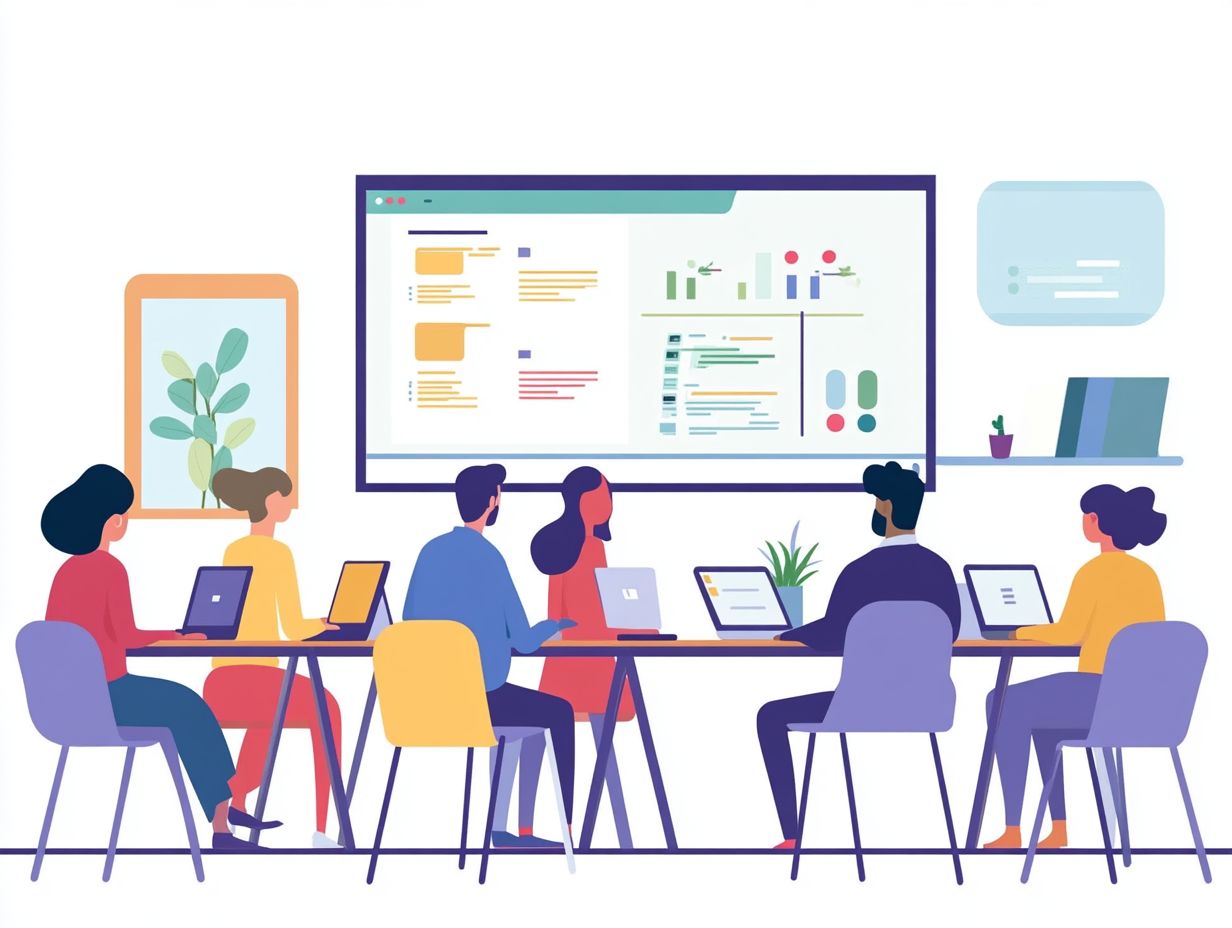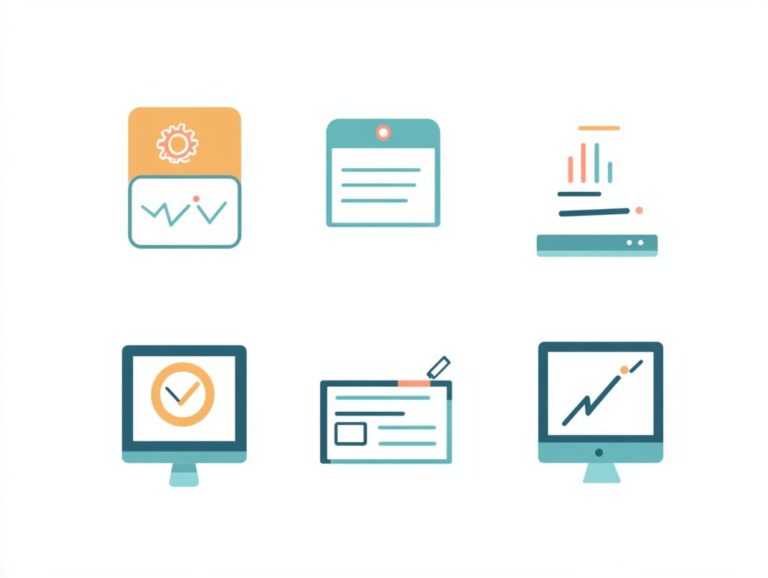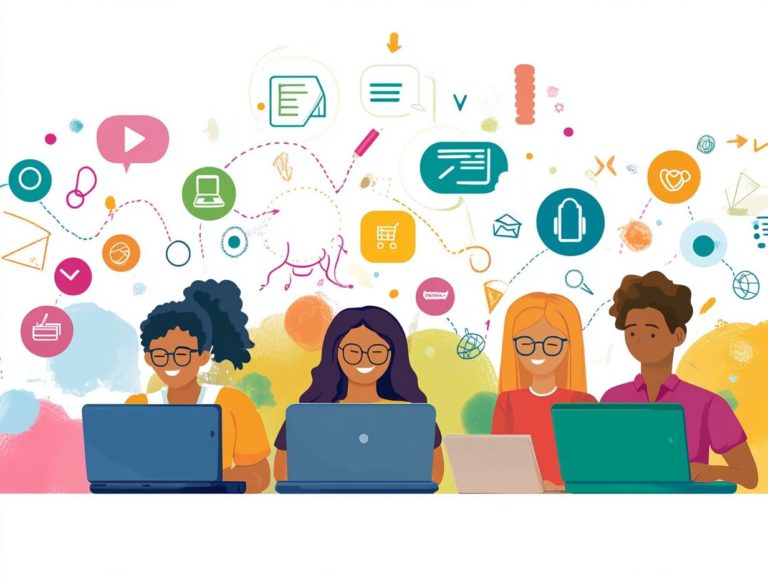Best Practices for Implementing E-Learning
E-learning has revolutionized your approach to education and training, providing flexible, accessible, and engaging learning experiences tailored to your needs.
As organizations like yours increasingly embrace digital learning solutions, grasping the fundamentals and benefits becomes essential.
This article outlines the key considerations for implementing e-learning effectively, from assessing your organization s readiness to crafting impactful programs.
You will also explore how to select the right platform, engage learners, and measure success, ensuring your e-learning initiatives yield maximum value.
Jump right in to discover powerful best practices that can transform your learning strategy!
Contents
- Key Takeaways:
- Understanding E-Learning
- Factors to Consider Before Implementing E-Learning
- Designing an Effective E-Learning Program
- Selecting the Right E-Learning Platform
- Training and Engaging Learners
- Measuring the Success of E-Learning
- Frequently Asked Questions
- What are some best practices for implementing e-learning?
- How can I ensure successful implementation of e-learning?
- What are the benefits of implementing e-learning?
- What should I consider when choosing an e-learning platform?
- How can I engage learners in e-learning?
- What are some common mistakes to avoid when implementing e-learning?
Key Takeaways:

- Consider organizational needs and readiness before implementing e-learning to ensure success.
- Design an effective e-learning program with key elements and strategies to engage and train learners.
- Measure the success of e-learning with key metrics and evaluation methods to continuously improve the program.
Understanding E-Learning
Definition
Understanding e-learning requires examining its definition, benefits, and its transformative influence on contemporary education. E-learning leverages technology to deliver educational content that enriches learning experiences and facilitates knowledge sharing to meet specific learning objectives.
Benefits
As digital platforms proliferate, e-learning courses have emerged as vital tools for addressing the demands of today’s learners, providing both flexibility and personalized learning paths.
Cultivating a feedback culture is essential to e-learning. It encourages continuous improvement in learning outcomes and enhances the effectiveness of course development.
Formats
E-learning is the art of delivering education and training through electronic means, using technology to create interactive learning experiences tailored just for you.
This innovative approach includes formats like online courses, webinars, and virtual classrooms, each crafted to accommodate diverse learning preferences and environments.
Online courses often grant you the freedom of on-demand content, allowing you to mold your study schedule around your personal needs.
Webinars provide real-time interaction with instructors, enhancing your learning experience through lively discussions and engaging Q&A sessions.
Virtual classrooms cultivate immersive environments where you can collaborate and socialize with peers in real-time. These formats help you achieve specific learning objectives and use success metrics to track engagement and outcomes effectively.
Factors to Consider Before Implementing E-Learning
Before diving into the world of e-learning, it’s essential to assess several critical factors, including creating effective assessments for e-learning, for a successful transition to digital training solutions.
Understanding the learning needs of your team, gauging organizational readiness, and selecting the right training strategies are pivotal in this evaluation process.
By pinpointing the specific requirements of your workforce and aligning them with suitable e-learning solutions, you can cultivate an environment that genuinely supports organizational learning and development.
Assessing Organizational Needs and Readiness
Assessing your organization’s needs and readiness is crucial for determining how effective your e-learning initiatives will be, particularly when considering the role of instructional design in e-learning.
Engaging in discussions with team members and conducting thorough performance evaluations can provide invaluable insights into your training deficiencies.
It’s vital to tailor your e-learning solutions to resonate with your workforce’s specific needs, ensuring that content aligns seamlessly with the desired outcomes, as detailed in this guide on how to measure e-learning effectiveness.
Fostering a culture of constructive feedback can enhance this process, allowing for continuous improvement and adaptation of your learning materials.
When these elements harmonize, they contribute to enriched learning experiences that propel both organizational performance and employee satisfaction to new heights.
Are you ready to elevate your e-learning strategy? Let’s get started!
Designing an Effective E-Learning Program

Designing an effective e-learning program requires a strategic approach that includes key considerations for e-learning content development. It should integrate e-learning design principles, learner engagement tactics, and clear learning objectives.
Using interactive learning methods can create content that resonates with today s learners. This fosters a deeper understanding of the material.
Key Elements and Strategies for Success
The elements for a successful e-learning program focus on engaging learners, interactive multimedia, and a strong feedback culture, which are crucial in developing a successful e-learning strategy.
Incorporating gamification using game-like elements can turn a static learning experience into a dynamic adventure. This motivates participation through challenges and rewards.
Fostering social learning environments encourages collaboration and insight sharing. This enhances understanding and retention of the material.
Effective feedback is crucial. Timely and constructive feedback helps learners identify areas for improvement.
Organizations can monitor metrics like completion rates and learner satisfaction scores to assess these strategies. These indicators link to better learning outcomes and overall growth.
Selecting the Right E-Learning Platform
Choosing the right e-learning platform is vital. It can significantly impact your training initiatives.
Evaluate key factors, including compatibility with course templates and user-friendliness. Also, consider the platform’s ability to foster remote collaboration.
Make sure the platform has features for collecting learner feedback. This keeps the training relevant and effective over time.
Key Features and Considerations
Focus on features that enhance the learning experience, such as interactive tools, tracking analytics, and scalability. To learn more about maximizing these benefits, check out how to utilize e-learning platforms effectively.
Features like quizzes and discussion forums boost engagement. They allow learners to test their knowledge and discuss topics with peers.
Multimedia capabilities, such as videos and simulations, cater to different learning styles. This makes content more enjoyable.
Strong analysis tools provide a clear picture of performance. They help educators identify what s working and what needs improvement.
Training and Engaging Learners
Effective training and engagement maximize your e-learning programs. Strategies like interactive multimedia, gamification, and real-world scenarios can create compelling content, especially when you learn how to use data to improve e-learning.
Fostering a culture of feedback gives learners control over their development. It drives continuous improvement in your training solutions.
Effective Techniques and Tools

Effective techniques and tools to enhance learner engagement include embracing microlearning, incorporating interactive learning activities, and fostering a robust feedback culture.
Microlearning breaks down complex subjects into small, manageable chunks. This approach allows you to absorb information more efficiently. Presenting content in these formats simplifies intricate concepts and accommodates different learning paces.
Pair this with interactive tools to significantly boost engagement. Invite learners to actively participate through quizzes, discussions, and simulations. This hands-on involvement deepens understanding and improves retention.
Cultivating a feedback culture is crucial. It creates an environment for continuous learning and adaptation, ensuring that training solutions remain relevant and effective. By gathering insights routinely, organizations can refine methods to align with evolving learner needs.
Measuring the Success of E-Learning
Measuring the success of e-learning initiatives is essential for understanding their impact and enhancing training solutions. Leverage various success metrics, including learner feedback, completion rates, and the alignment of outcomes with predefined learning objectives.
Adhering to e-learning best practices ensures that your evaluation process is thorough and effective, leading to enriched learning experiences.
Key Metrics and Evaluation Methods
Key metrics and evaluation methods for measuring e-learning success include performance analysis.
These evaluation techniques delve deeper than surface-level assessments. Incorporate surveys to capture subjective learner experiences, assessments to quantify knowledge acquisition, and analytics to track engagement patterns.
These insights pinpoint areas that need enhancement, enabling tailored adjustments that resonate with learner needs.
This data-driven approach is your key to crafting courses that truly resonate with learners, ensuring content remains relevant, engaging, and impactful.
Frequently Asked Questions
What are some best practices for implementing e-learning?
Some best practices include:
- Creating a clear and organized course structure.
- Providing engaging and interactive content.
- Incorporating multimedia elements.
- Regularly evaluating and updating the course.
How can I ensure successful implementation of e-learning?

To ensure successful implementation, involve all stakeholders in the planning and development process. Providing comprehensive training and support is crucial; additionally, avoiding the top mistakes in e-learning implementation can help enhance the experience. Communicate regularly with learners to gather feedback and make improvements.
What are the benefits of implementing e-learning?
E-learning offers many benefits, such as:
- Flexibility for learners to access materials at their own pace.
- Cost-effectiveness.
- Scalability for reaching a larger audience.
- The ability to track and measure learner progress and performance.
What should I consider when choosing an e-learning platform?
When choosing a platform, consider:
- Features and functionalities offered.
- Compatibility with existing systems.
- User-friendliness.
- Security measures.
- Customer support.
- The needs and preferences of your learners.
How can I engage learners in e-learning?
To engage learners, incorporate interactive elements like:
- Quizzes and games.
- Simulations.
- Opportunities for collaboration and discussion with peers.
- A variety of multimedia content to cater to different learning styles.
What are some common mistakes to avoid when implementing e-learning?
Are you ready to dive into e-learning? Avoid these common pitfalls to ensure success!
Some mistakes include not planning ahead and giving learners too much information at once. Also, provide adequate support and resources, and regularly evaluate and update the course to meet learner needs.






